Grow a Pear
When I semi-retired from logging in the fall of 2013, I decided to pursue a longed-for endeavor of growing some of my favorite fruit. In the spring of 2014, I began planting like the dickens with my oldest daughter Morgen, who lives next door with her husband and my two favorite (only) grandchildren. Thirty blueberries, some raspberries, two plum trees, a cherry tree, six apple trees, hazelberts (a cross between a hazel nut and a filbert), elderberries, goose berries. And pears. When I was a kid, an uncle of mine had an old pear tree hanging on next to the milk house on his dairy farm in Hinesburg. The pears were the best I ever ate – I never had a store-bought pear that came close to them.
Today we have four pear trees that are doing quite well: a Golden Spice, two Ure, and a Waterville. The Waterville variety was started from a tree growing in an old orchard up in Waterville, Vermont, so we know it’s tougher than wang leather. The Ure’s trace their roots back to Siberia, so pretty tough, too. Both started blossoming earlier this week. And if the frost is gone for good, I’m thinking we might get a decent crop this year.
Our pears have been some of the easiest trees to grow. They seem to have fewer insect problems than other fruit trees. Pollination can be tricky (part of the reason for this is that the blossoms aren’t that sweet, so honeybees don’t love them, especially compared to apple blossoms). But if you plant several complimentary varieties together, it helps stack the deck. It typically takes five to seven years from planting to produce a full crop. And while we’ve only gotten a few pears in the last two years, right now I’m feeling optimistic. These trees have taken the worst that our tough West Bolton weather has thrown at them and came through it. Ain’t lost a one. It makes me trust that there will be sunny, fruitful days ahead.
– Bill Torrey

